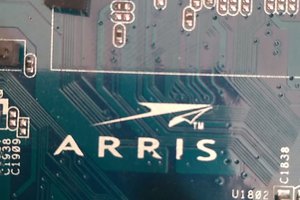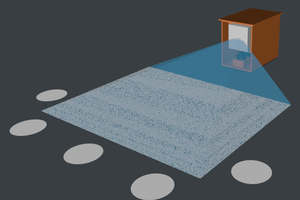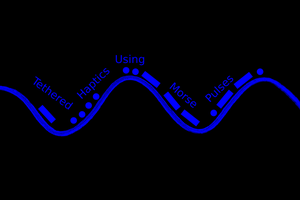Using a wheelchair for someone who is used to walking about normally brings the need for new learned behaviours and precautions. The most common and dangerous problem I have encountered with Mom is that she forgets to set the Brakes when getting into and out of the Chair moving about from the couch, bathroom, kitchen, etc.
Simply using positional sensors on the brakes is not good enough because the chair needs to be moved when not occupied (to position it, or move it out of the way / load it into the back of the Jeep), and the Brakes need to be off when sitting in the chair so it can be maneuvered by its occupant.
Detecting movement of the chair using an accelerometer also leads to many "false positives" because, again, it is not uncommon to move it for repositioning when it is not occupied.
But the canvas seat of the chair has lots of "play" when not occupied, just as folding canvas beach chairs do. This is required because like beach chairs, the wheelchair also folds up for stowing when transferring to/from a vehicle.
Along, finally, comes an application for Conductive Rubber Cord. It can be run along the bottom of the canvas seating area to make it somewhat flat, but will have little "stretch" applied and be in a "relaxed" state. As the Rubber Cord is stretched, its resistance increases! This can add another dimension to sensing by knowing if someone is actually sitting IN the chair at any given time.
Combining this indication along with accelerometer data, and positional tilt-ball sensors on the Brakes gives a whole picture of what the wheelchair occupant is doing or attempting to do, and alert to unsafe / unstable conditions which could cause a fall embarking / disembarking the chair.
This Project will have a length of the Conductive Rubber Cord under the seating area, a triple-axis accelerometer to detect movement (intentional or accidental), and Tilt Ball Switches (like old-school mercury switches, but immune to the fluid being 'sloshed' around sending false indications) for detecting the state of the Brakes.
In addition, it will be equipped with a Bluetooth BLE/BT Smart Beacon so that RSSI signal strength can be measured from various fixed-point receivers around the house so the system (and me) have an idea of what the occupant is doing or where they are or are heading.
Data from the 3 means of on-chair sensors will be used to set off alerts to remind the user that they are about to do something potentially dangerous, and will also be tracked via BT Beacon techniques, and finally connected WiFi to a base monitor / gateway to alert others locally about what is happening in real-time and offer Networked Monitoring as well using the Internet and Push Notifications using AWS (Amazon Web Services) IoT.
The Tilt Sensors for brakes, the accelerometer, and A/D measurement (via resistor divider network to measure the Rubber Cord Resistance) will be processed using a TinyDuino "stack" which includes the 3-Axis, 10-bit, +/-16g TinyShield, TinyDuino Low Energy Bluetooth 4.0 (nRF8001) Shield, and the TinyDuino WiFi Shield. The Base Station and AWS IoT Gateway will be handled with the Raspberry Pi3 since it in-built WiFi supports the needed TLS credentialing required by Amazon, and the BT 4.0 for detecting the Beacon created by the chair's nRF8001.
If there is no need for connecting to the Cloud in a secure manner (ala AWS, IBM BlueMix), then the RPi3 can be replaced with an Adafruit Feather Huzzah (processor and WiFi) and Adafruit Bluefruit LE Friend.
 Grayson Schlichting
Grayson Schlichting

 Timescale
Timescale
 Lee Djavaherian
Lee Djavaherian
 Daren Schwenke
Daren Schwenke